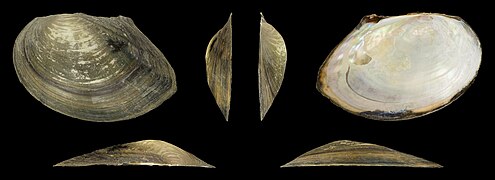| Sinanodonta woodiana | |
|---|---|

| |
| Two live individuals of Sinanodonta woodiana in Imutaike Prefectural Natural Park, Japan | |

| |
| River March, Austria | |
| Conservation status | |
 Least Concern (IUCN 3.1) | |
| Scientific classification | |
| Domain: | Eukaryota |
| Kingdom: | Animalia |
| Phylum: | Mollusca |
| Class: | Bivalvia |
| Order: | Unionida |
| Family: | Unionidae |
| Genus: | Sinanodonta |
| Species: | S. woodiana |
| Binomial name | |
| Sinanodonta woodiana (I. Lea, 1834) | |
| Synonyms | |
|
Anodonta woodiana (I. Lea, 1834) | |
Sinanodonta woodiana, the Chinese pond mussel, Eastern Asiatic freshwater clam or swan-mussel, is a species of freshwater mussel, an aquatic bivalve mollusk, in the family Unionidae (the river mussels).
Right and left valve of the same specimen:
Distribution
- Indigenous to Eastern Asia
- Non-native/introduced to Europe:
- non-native on some Indonesian islands
- non-native in the Americas:
- Costa Rica
- Dominican Republic
- United States (extirpated from New Jersey)
- non-native in Africa:
- Algeria– non-native in Oubeira Lake since 2023
- Myanmar – non-native; first reported in 2017
Ecology
Sinanodonta woodiana, the Chinese pond mussel, is a species of East Asian freshwater unionid bivalve mollusk primarily known from the Amur River, in the Russian Far East, and China's Yangtze River. The Chinese pond mussel can grow to 30 cm and attain an age of 12–14 years, and they can reproduce by the end of their first year, while only 3–4 cm in size.
This large, freshwater bivalve is a habitat generalist, with a high silt tolerance. It is established worldwide; like all unionid mussels, it has an obligatory parasitic stage (glochidium), in which the larva must encyst on a host fish to complete its development. Host species include invasive, non-native and native fishes. The presence of S. woodiana can seriously affect local unionid populations.
S. woodiana's great success is attributed to the importation and commercialisation of Asian carp, its native Asian host, which is now found worldwide, as well. S. woodiana was introduced in Tuscany both inadvertently and intentionally, for artificial/imitation pearl production. The species is also sold in some garden centers as biofiltration for outdoor ponds and water features.
Parasites:
References
- Cummings, K. (2011). "Sinanodonta woodiana". IUCN Red List of Threatened Species. 2011: e.T166313A6198609. doi:10.2305/IUCN.UK.2011-2.RLTS.T166313A6198609.en. Retrieved 20 November 2021.
- ^ Beran, L. (2002) Vodní měkkýši České Republiky – rozšíření a jeho změny, stanoviště, šíření, ohrožení a ochrana, červený seznam. Aquatic molluscs of the Czech Republic – distribution and its changes, habitats, dispersal, threat and protection, Red List. – Sborník přírodovědného klubu v Uherském Hradišti, Supplementum 10, 258 pp.
- Beran L. (1997). "First record of Sinanodonta woodiana (Mollusca: Bivalvia) in the Czech Republic". Acta Societatis Zoologicae Bohemicae 61: 1–2.
- Novák J. (2004) Třetí potvrzený nález škeble asijské v ČR. https://www.biolib.cz/cz/article/id2/
- (in Czech) Horsák M., Juřičková L., Beran L., Čejka T. & Dvořák L. (2010). "Komentovaný seznam měkkýšů zjištěných ve volné přírodě České a Slovenské republiky. ". Malacologica Bohemoslovaca, Suppl. 1: 1–37. PDF.
- Ioannis Karaouzas; Duarte V. Gonçalves; Nicoletta Riccardi; Simone Varandas; Elsa Froufe; Stamatis Zogaris; Manuel Lopes-Lima (22 December 2021). Laura Garzoli; Karolina Bącela-Spychalska (eds.). "First established population of the Chinese pond mussel Sinanodonta woodiana" (PDF). BioInvasions Records. 11. Archived from the original (PDF) on 17 February 2022. Retrieved 27 June 2023.
- Popa, Oona P.; Kelemen, Beatrice S.; Murariu, Dumitru; Popa, Luis A. (2007). "New records of Sinanodonta woodiana (Lea, 1834) (Mollusca: Bivalvia: Unionidae) from Eastern Romania". Aquatic Invasions. 2 (3): 265–267. doi:10.3391/ai.2007.2.3.12.
- Distribution of Anodonta (Sinanodonta) woodiana (Rea, 1834) in inland waters of Serbia "Archived copy" (PDF). Archived from the original (PDF) on 19 April 2009. Retrieved 17 May 2007.
{{cite web}}: CS1 maint: archived copy as title (link) - Nagel K.-O. & Šteffek J. 2005: Sinanodonta woodiana (Lea) na východnom Slovensku. – Telekia (Michalovce), 3: 35–36.
- Pou-Rovira, Q.; R. Araujo; D. Boix; M. Clavero; C. Feo; M. Ordeix & L. Zamora (2009). "Presence of the alien chinese pond mussel Anodonta woodiana (Lea, 1834) (Bivalvia, Unionidae) in the Iberian Peninsula" (PDF). Graellsia. 65 (1): 67–70. doi:10.3989/graellsia.2009.v65.i1.137.
- Vikhrev, I. V., Konopleva, E. S., Gofarov, M. Y., Kondakov, A. V., Chapurina, Y. E., & Bolotov, I. N. (2017). "A Tropical Biodiversity Hotspot Under the New Threat: Discovery and DNA Barcoding of the Invasive Chinese Pond Mussel Sinanodonta Woodiana in Myanmar". Tropical Conservation Science 10: 1940082917738151.
- US Fish and Wildlife Service, 2015. "Chinese Pond Mussel (Sinanodonta woodiana) Ecological Risk Screening Summary"
- Douda, K., Vrtílek, M., Slavík, O., & Reichard, M. (2012). The role of host specificity in explaining the invasion success of the freshwater mussel Anodonta woodiana in Europe. Biological Invasions 14:127–137..
- Pavljuchenko, O. V. (2005) The first record of the helminth Aspidogaster conchicola (Aspidogastrea) in Sinanodonta woodiana (Mollusca, Bivalvia) from Ukraine. – Vestnik Zoologii, Schmalhausen Institute of Zoology, National Academy of Sciences of Ukraine, Vol. 39(3): page 50.
| Taxon identifiers | |
|---|---|
| Sinanodonta woodiana |
|

